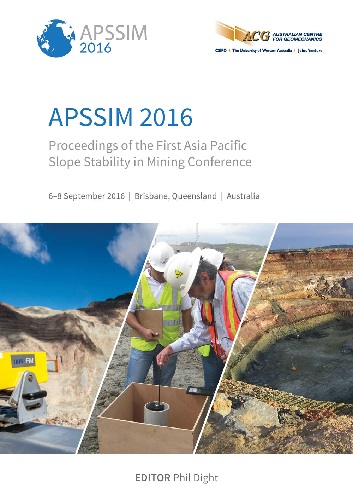Three-dimensional numerical modelling of potential structurally controlled failure mechanisms at the Kanmantoo open pit

|
Authors: Sainsbury, DP; Vakili, A; Lucas, DS; Hutchison, BJ |
DOI https://doi.org/10.36487/ACG_rep/1604_05_Sainsbury
Cite As:
Sainsbury, DP, Vakili, A, Lucas, DS & Hutchison, BJ 2016, 'Three-dimensional numerical modelling of potential structurally controlled failure mechanisms at the Kanmantoo open pit', in PM Dight (ed.), APSSIM 2016: Proceedings of the First Asia Pacific Slope Stability in Mining Conference, Australian Centre for Geomechanics, Perth, pp. 143-156, https://doi.org/10.36487/ACG_rep/1604_05_Sainsbury
Abstract:
The Kanmantoo Copper Mine is located 55 km southeast of Adelaide, South Australia, and is owned and operated by Hillgrove Copper Pty Ltd (HGO). The largest of three currently operating pits at Kanmantoo is the Giant Pit, which is operating over HGO’s recently completed Kavanagh Pit which was mined to a depth of 240 m. The Giant Pit, in which mining is currently taking place in the upper benches, will extend to a maximum depth of 380 m with steeper overall slope angles. Mining of the Kavanagh Pit provided a valuable understanding of the geotechnical controls on slope stability and the efficiencies that could be achieved in the design of the Giant Pit. The high-strength intact rock and four distinct structure sets impose specific structural controls on the stability of all pit walls, which are well understood and well controlled from the experience of mining the Kavanagh Pit. HGO recognised that if small-scale failures could be controlled, better crest retention and improved berm capacity would be achieved, thereby enabling steeper overall slope angles. Although no deep seated failures have occurred to date, the steeper overall slope angles, and the greater depth of the Giant Pit prompted concerns about the possibility of larger-scale, deeper-seated failures that may include a combination of sliding on structures and shearing through rock. The deep pit and steep walls also prompted concerns about the potential impact of mining induced stresses. Numerical modelling was conducted using the three-dimensional distinct element code 3DEC, which represents the rock mass as a combination of deformable finite difference zones and discrete discontinuities. To adequately represent the jointed rock mass and the structural controls on stability of each pit wall, structures needed to be represented explicitly as discontinuities in the 3DEC models. Discrete fracture networks were generated to include discontinuities of an intermediate scale with relative frequencies, lengths and spacing appropriate for each structure set. This work has demonstrated that complex jointed rock masses can be simulated successfully in numerical models by the use of a combination of appropriately spaced discrete structure and rock mass blocks, in a way that represents the key structural controls observed in the mined pit slopes. Besides representing the overall rock mass behaviour more realistically, such models can also better capture the influence of excavation sequences and both in situ and mining induced stresses, therefore, providing useful insight on the behaviour of the excavation that can be used for both mine planning and design.
Keywords: slope stability, numerical modelling, 3DEC, Kanmantoo Mine, Hillgrove Resources
References:
Barton, N & Bandis, S 1982, ‘Effects of block size on the shear behaviour of jointed rock’, in Proceedings of the 23rd US Symposium on Rock Mechanics, p. 739–760.
de Bruyn, IA, Coulthard, MA, Baczynski, NRP & Mylvaganam, J 2013, ‘Two-dimensional and three-dimensional distinct element numerical stability analyses for assessment of the west wall cutback design at Ok Tedi Mine, Papua New Guinea,’ in PM Dight, Proceedings of the International Symposium on Slope Stability in Open Pit Mining and Civil Engineering, Australian Centre for Geomechanics, Perth, pp. 653–668.
Hutchinson, BJ & Howarth, J 2015, ‘Kanmantoo Mine rockfall and rock wall failures: I-Site 8820 laser scanning applications,’ in Proceedings of the International Symposium on Slope Stability in Open Pit Mining and Civil Engineering, The Southern African Institute of Mining and Metallurgy.
Itasca 2013, 3DEC, Three-Dimensional Distinct Element Code, version 5.0, Itasca Consulting Group, Inc., Minneapolis.
Lee, M, Molison, L, Campbell, A & Litterbach, N 2010, ‘Rock Stresses in the Australian Continental Tectonic Plate – Variability and Controls’, in 11th IAEG Congress – Geologically Active New Zealand.
Riahi, A & Curran, JH 2009, ‘Full 3D finite element Cosserat formulation with application in layered structures’, Applied Mathematical Modeling, vol. 33, no. 8, pp. 3450–3454.
Sainsbury, DP, Pothitos, F, Finn, D & Silva, R 2007, ‘Three-Dimensional Discontinuum Analysis of Structurally Controlled Failure Mechanisms at the Cadia Hill Open Pit,’ in Y Potvin (ed.), Proceedings of the 2007 International Symposium on Rock Slope Stability in Open Pit Mining and Civil Engineering, Australian Centre for Geomechanics, Perth, pp. 307–320.
Vakili, A, Teet, R, Woo, K, de Veth, A & Penney, A 2014, ‘Understanding Critical Parameters in Stochastic Discrete Fracture Networks’, DFNE 2014, Vancouver.
© Copyright 2025, Australian Centre for Geomechanics (ACG), The University of Western Australia. All rights reserved.
View copyright/legal information
Please direct any queries or error reports to repository-acg@uwa.edu.au
View copyright/legal information
Please direct any queries or error reports to repository-acg@uwa.edu.au